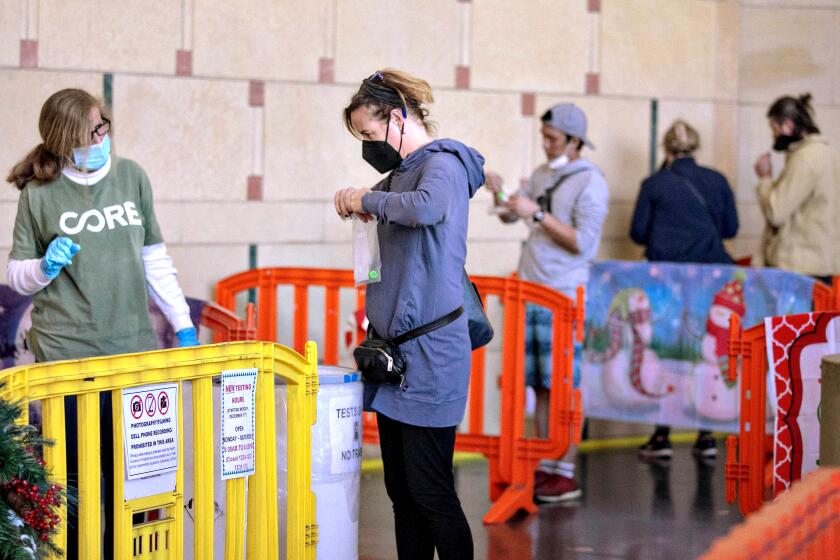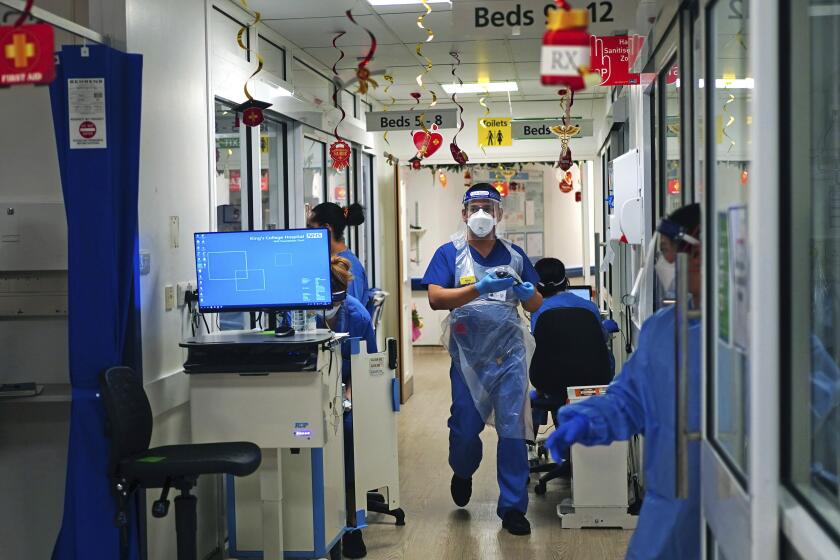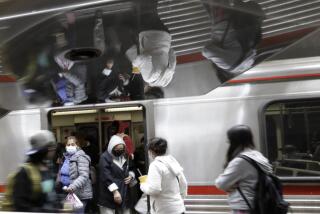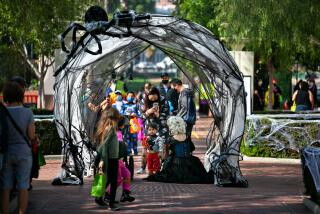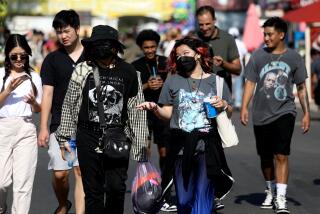Is it safe to eat at restaurants amid Omicron surge? Here’s what the experts say
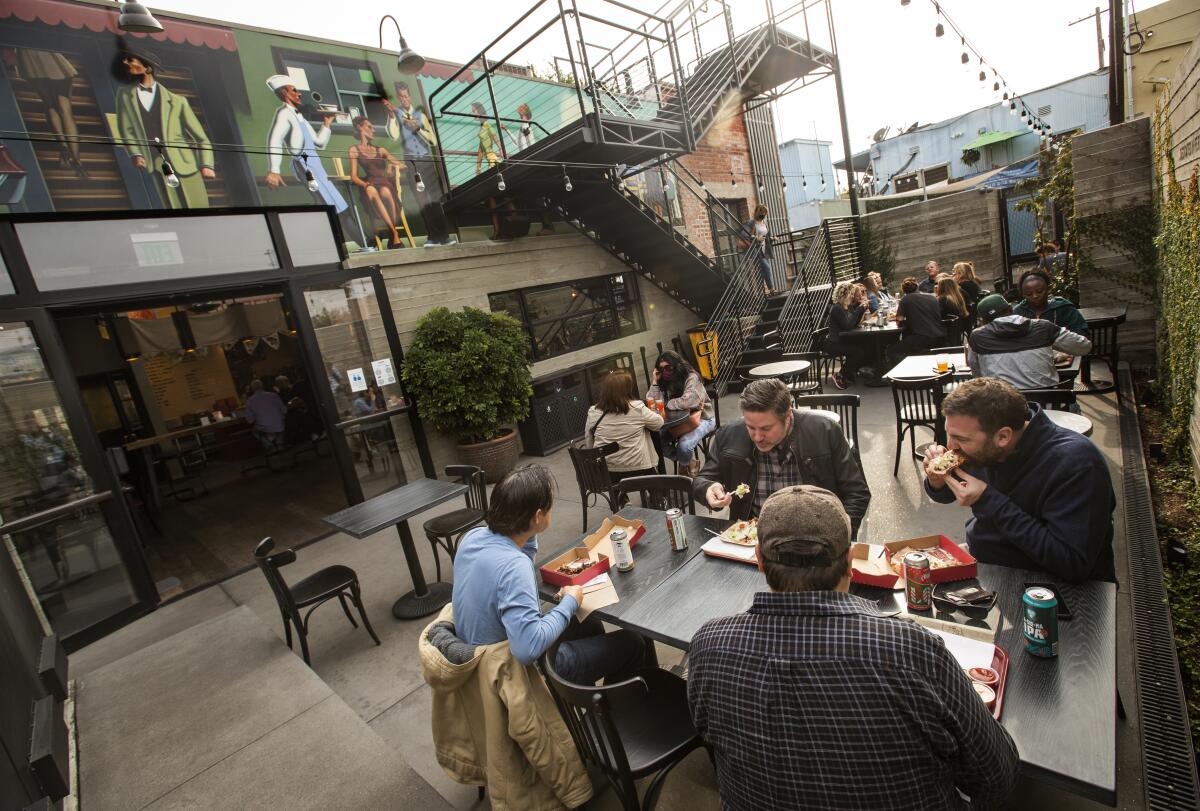
- Share via
With the Omicron variant now spreading fast across California, is it still safe to dine out?
Public health officials have stressed they don’t intend to impose any new lockdown restrictions of the kind that were ordered last year, such as closing down indoor restaurant areas. Some cities, such as Los Angeles, West Hollywood, San Francisco and Berkeley, have instead imposed rules requiring customers to show proof of vaccination to eat in indoor dining rooms.
Overall, the decision on dining out comes down to a personal assessment of risk — something that could be affected by how old you are, your underlying conditions, local rates of coronavirus transmission and the effect on your family, friends and work should you become infected.
Infectious disease experts widely agree that outdoor dining is a much safer bet. Some doctors who haven’t eaten in an indoor restaurant since the pandemic began have eaten outdoors.
A giant indoor holiday party with dozens of guests, in a stuffy room, is far more risky. Los Angeles County Public Health Director Barbara Ferrer said she is discouraging large indoor gatherings.
In some sobering examples of how the coronavirus can quickly spread, a Christmas holiday party at an indoor restaurant in Oslo left 80 of more than 110 attendees infected, most of whom are believed to have contracted the Omicron variant. Most attendees were vaccinated with two doses of an mRNA vaccine, and everyone had to show a negative test, taken one to three days before the gathering.
It wasn’t just attendees of that party who got infected, however. More than 60 other people who visited the same restaurant on the same night as the Christmas party also were infected.
In Marin County, at least 28 people tested positive after attending a holiday gathering at a restaurant; attendees weren’t wearing masks because a statewide indoor mask mandate had not yet taken effect. All guests were required to be vaccinated and provide proof of a negative at-home test the day of the party, and many guests had received booster shots.
Scientists now say it’s clear the coronavirus is airborne, and early data suggest it can hang in the air for an hour or two after an infected person leaves.
Getting vaccinated and a booster shot is generally expected to protect most people from severe illness and death. Still, officials expect more vaccinated people, including those who have been boosted, will get infected with the Omicron variant. Vaccinated people can still transmit the virus to others who may be more vulnerable should they get infected.
Infections are also disruptive, requiring people to isolate for at least 10 days following the onset of symptoms or a positive test.
So where does that leave indoor restaurant dining experiences that don’t involve parties in which multiple parties are mingling with each other?
California’s winter COVID-19 surge intensified Wednesday, with new overall coronavirus cases likely tied to holiday gatherings spiking up, along with confirmed cases of the Omicron strain.
What experts say
- Dr. Peter Chin-Hong, an infectious disease expert at UC San Francisco, said Thursday if he had a compromised immune system, or was elderly and was either unvaccinated or had not received a booster shot, he would not dine in an indoor restaurant. His feelings about dining indoors could change, but for now, since he is healthy and has received his booster shot, he said he feels OK about dining indoors in a well-ventilated space, but added he’s definitely wearing a well-fitted, non-cloth mask when walking to the table and to the restroom. Cloth masks alone, while better than nothing, as not as effective as higher-grade masks, such as surgical masks and KF94, KN95 and N95 masks.
- Dr. Paul Sax, an infectious diseases expert at Harvard Medical School, said at a recent UC San Francisco online forum that he hasn’t dined inside a restaurant since the spring of 2020, and “I miss it greatly. I’m going to put that off until case numbers drop some more.” Sax said that the superspreader event inside the Oslo restaurant in November is a classic example of how rapidly the virus can be transmitted in an indoor environment, even among vaccinated people. But Sax said he will still dine at an outdoor restaurant. “Airborne viruses get distributed, diluted by ventilation so efficiently outside. I’ve eaten outside in many restaurants. It’s just very hard to do in Boston in the wintertime,” Sax said.
- Dr. Robert Wachter, chair of the UC San Francisco Department of Medicine, said last week on Twitter that, as a fairly healthy 64-year-old who is moderately risk-averse and has received three shots of the Pfizer vaccine, he would not dine in an indoor public setting even in San Francisco, but he would eat outdoors. He also noted that “context matters: What might be safe for a healthy 30-year-old could be way too unsafe for a frail octogenarian.” “It’s not about you alone. That healthy 30-year-old can spread COVID unwittingly to someone at high risk, including a loved one. So decisions about risk need to account for risk to others,” Wachter wrote.
Barbara Ferrer, the director of the Los Angeles County Department of Public Health, follows three rules for staying safe during the pandemic, although she doesn’t specifically address whether she dines at restaurants:
- Get vaccinated and boosted.
- Get tested when you’re going to be in high-risk situations for you or those around you, or if you’ve been exposed to a COVID-19-positive person or have symptoms yourself.
- Wear a mask when you’re indoors in a public place or with people outside of your household.
Ferrer said she will not attend nor host any large parties during this normally festive season.
Here’s what scientists are watching for as they gauge what Omicron has in store for us this winter.
Vaccination proof rules
In some parts of the state, patrons are required to demonstrate they’ve been vaccinated for COVID-19 before they’re allowed to dine indoors.
That’s the case in the city of Los Angeles, which last month began enforcing its mandate that patrons prove they’ve been vaccinated against COVID-19 as a condition of entering a host of indoor businesses.
The city’s program, called SafePassLA, covers not only restaurants, but bars and coffee shops; live performance venues; tattoo and piercing parlors, sports arenas and convention centers; exhibition halls and museums; tasting rooms at breweries, wineries and distilleries; cafeterias, food courts, banquet halls and hotel ballrooms; gyms, and dance and fitness studios; movie theaters, family entertainment centers, bowling alleys, arcades, card rooms and pool halls; and spas, hair and nail salons.
Other jurisdictions, including San Francisco, West Hollywood and Berkeley, have similar rules. Oakland said it would adopt similar rules this week.
However, such verification requirements aren’t in place everywhere. Wider Los Angeles County, for instance, has a far more limited set of rules — requiring proof of COVID-19 vaccination only at indoor bars, wineries, breweries, distilleries, nightclubs and lounges.
In either case, officials credited businesses with overwhelmingly following the rules to this point. Ferrer said this week that inspections have found more than 90% of visited bars, lounges and restaurants have been in compliance with the vaccine-verification requirements.
More to Read
Sign up for Essential California
The most important California stories and recommendations in your inbox every morning.
You may occasionally receive promotional content from the Los Angeles Times.
